While Kir Royal is made with Champagne or other sparkling wines instead of white wine, Kir is the original preparation with dry white wine. Both cocktails are incredibly fancy, delicious, and refreshing, making them perfect for any occasion.
What it is: A vine or champagne cocktail hailing from France, more specifically, from the Burgundy region with a long history.
The difference between kir and kir royal: Kir is with white wine, kir royal is with sparkling wine or Champagne.
What is it flavored with? Blackcurrant liquor is the traditional way to prepare it. There are other possible substitutes to get a slightly sweet taste and delicious flavor.
When to serve it: It’s a fancy cocktail for parties and dinners, but try a more economical way with sparking wine or dry wine for any occasion.
The story behind Kir
You know that I love to dig into my gastronomy and history books to learn the origins and history of French dishes. Kir has a fascinating story.
Where it comes from
Kir and Kir Royal’s history is rooted in France’s Burgundy region. It was originally made with a blend of one-third Crème de Cassis blackcurrant liquor from the city of Dijon and two-thirds Bourgogne Aligoté wine.
Aligoté white wine is made from the Aligoté grape variety, an ancient plant that is the second most important white grape variety in Burgundy after Chardonnay.
This 1/3 – 2/3 proportion may seem too sweet nowadays. We tend now to reduce the amount of blackcurrant alcohol to a ratio of 1/5 Crème de Cassis and 4/5 white wine.
Why did the French start adding a fragrant and sweetening element like Crème de Cassis in white wine? It’s said to break down the acidity of white wine.
Who invented it
The Kir was actually invented in 1904 in a café of the City of Dijon in Burgandy named Montchapet.
The former owners of this bar-tabac claim that the drink originated from a mistake. At the time, people were drinking pure crème de cassis.
One day, the waitress accidentally poured white wine into the mayor’s glass of crème de cassis (the mayor was a regular customer as he lived above the café). The mayor would have liked it, and the beverage – then called blanc-cassis or blanc-cass its nickname (lit. white-blackcurrant) – would have remained.
Others say that the café owner confused Vermout with Bourgogne aligoté. Who knows!
How it became famous all over France
The drink quickly became very popular in the Dijon region at the beginning of the 20th century. It was the traditional drink offered at receptions hosted by the Dijon City Hall. Some say it replaced Champagne to save money as it was less expensive.
Chanoine Félix Kir (1876-1968), a priest, Deputy of Côte d’Or region, and Mayor of the city of Dijon from 1945 to 1968, gave his name to the drink and made it famous out of Dijon. He used to order this drink at the bar of French National Assembly. In 1951,
Chanoine Kir authorized the company Lejay-Lagoute, an alcohol producer who created Crème de Cassis in 1841, to use the name Kir in advertising.

What is a kir
Which white wine to choose
Bourgogne aligoté, of course, as the traditional recipe, or any dry white wine. Chardonnay or Muscadet, for example.
Blackcurrant liqueur or other fruit liqueur
Originally, it was Dijon crème de cassis, a blackcurrant liqueur originally produced in the Dijon area as explained earlier. Crème de cassis is a sweet, dark red liquor made from blackcurrants.
Today, many other fruit liquors can be used to make kirs in a wide range of flavors.
However, in France, we often stick to red or black fruits, such as blueberry (the one in the photo is from a local distillery in the South Alps, where I go every year), blackberry, raspberry… You can also try peach cream, for example.
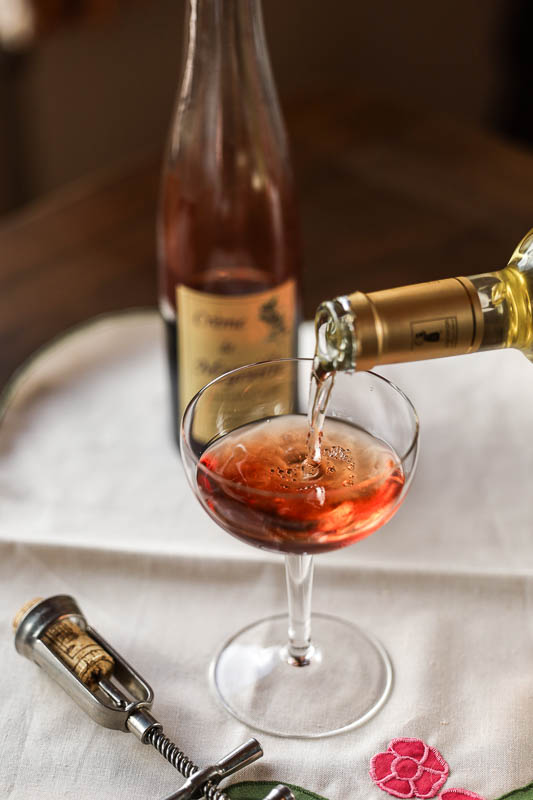
Kir variations
In addition to fruit liqueur substitutes, France has many fun regional adaptations. Purists will say it’s not the real Kir, but some are worth trying! I’ve listed a few:
- Kir lorrain: mirabelle plum liqueur and dry white wine
- Kir breton: fruit liqueur and apple cider (+ possibly a dash of mead)
- Kir médocain: blackcurrant liqueur and Médoc rosé wine.
- Kir cardinal or Kir communard: blackcurrant liqueur and red wine I’ll have to check the difference between the two.
- Kir ardéchois: chestnut liqueur and dry white wine
- Kir normand: calvados and apple cider
- Canisse: blackcurrant liqueur, pastis (anise flavors alcohol), and water
- Marcassin: blackcurrant liqueur, marc de Bourgogne
- Double K: blackcurrant liqueur / crème de cassis, Bourgogne aligoté and Vodka, a cocktail invented by Chanoine Kir and Nikita Khrushchev (hence the two Ks).
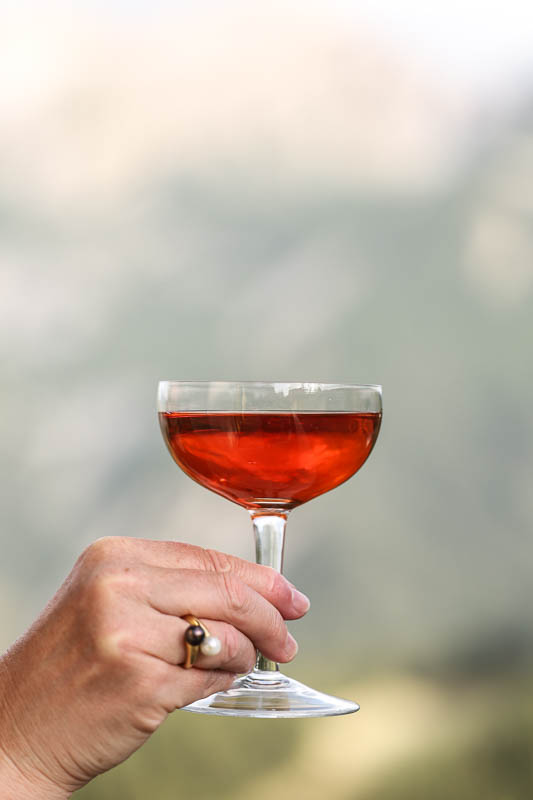
Focus on Kir Royal
The Kir Royal was originally made with Crémant de Bourgogne, a sparkling white wine from Burgundy, not Champagne.
Why royal? Certainly because a sparkling beverage, Crémant or Champagne, is synonymous with a noble drink. A royal drink.
The French write Kir Royal without an “e” at the end. Kir royal is the correct spelling, not Kir Royale.
Today, the fancy Champagne often replaces Crémant. If you want to serve with Champagne, choose a chilled brut Champagne, but don’t put too much money on a high-quality Champagne as with blackcurrant liquor; most might not see the difference.
In France, sparkling or effervescent wine can only be called Champagne if produced in the Champagne region.
France has many other sparkling wines (white, rosé and even red), often called crémant (crémant or crémant plus the region or origin: crémant de Loire, crémant d’Alsace, crémant de Bourgogne…), with a specific local name (for example Clairette de die) or is simply called mousseux (mousse in French means foam).
Some are said to be done according to the méthode champenoise, which means the same process as Champagne.
Choose an effervescent sparkling wine for a cheaper version or if you don’t have Champagne. The crémants as just explained or even Prosecco or your local effervescent wine.
The recipe and the proportions for kir royal are identical to a classic kir with white wine. The only difference is that effervescent wine or Champagne replaces white wine.

In which occasion shall you serve kir or kir royal?
In France, Kir and Kir royal are both often associated with a feast when you have to celebrate something.
Why limit ourselves to special occasions like Christmas or New Year Eve? Try a chilled kir for a summer aperitif instead of rosé, or a kir royal with a sparkling wine less expensive than Champagne, a Crément de Bourgogne, for example, as this Burgundian appetizer was originally served.
I took those photos during an appetizer on a warm evening in the French Alps; you might see the mountains in the back. I only had a crème de myrtille blueberry liquor produced in that lost valley in the Southern part of the French Alps. Next time I get the chance, I promise I’ll take photos of Kir Royal in a more festive Parisian atmosphere, with crème de cassis blackcurrant liquor.
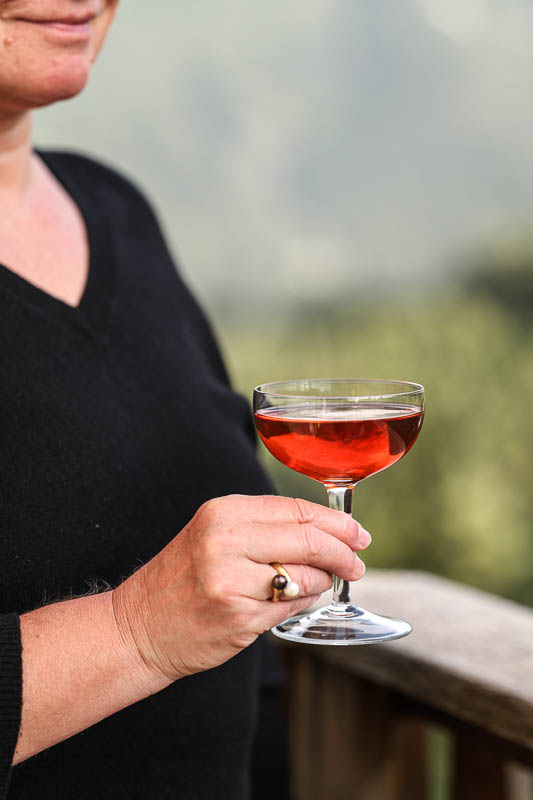
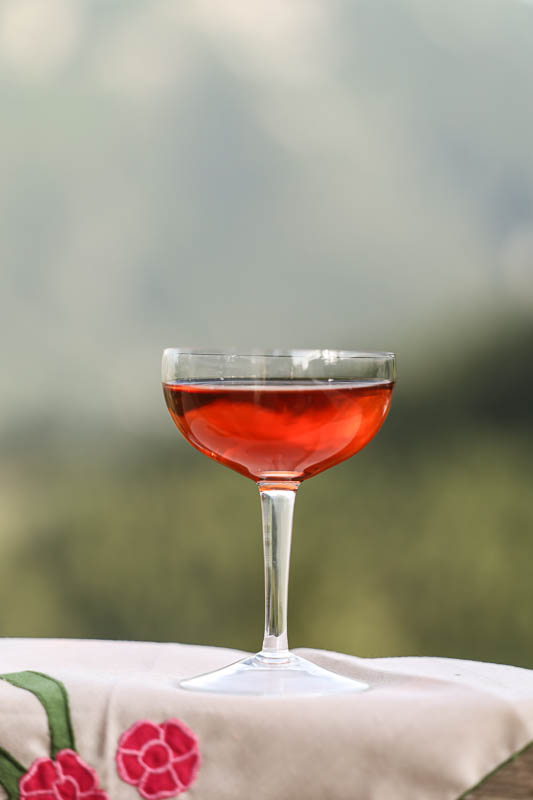
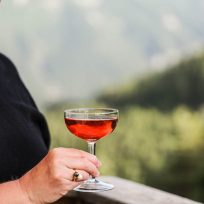
kir and Kir royal
Ingredients
For 1 kir
- 2 cl blackcurrant liqueur (crème de cassis) or other fruit liqueur
- 8 cl dry white wine Bourgogne aligoté or other chilled dry white wine, Chilled
For 1 kir royal
- 2 cl blackcurrant liqueur (crème de cassis ) or other fruit liqueur
- 8 cl Champagne or sparkling wine: Crémant Burgundy Loire, Alsace… Chilled
Instructions
- Pour the crème de cassis into the glass.
- Then pour in the chilled white wine or Champagne, depending on whether you want a kir or a kir royal.
- Stir if necessary.
Notes
The Kir in the photos is made with blueberry crème, not traditional but very good. Read in the article the fascinating story behind this French cocktail.
